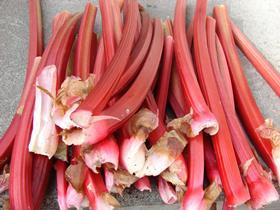
Much like the short-back-and-sides hairdo and sportswear as an everyday fashion item, rhubarb is enjoying a return to popularity in the UK.
According to Pudsey-based forced rhubarb grower David Tomlinson, his business had at one point gone down from 12 rhubarb sheds to one shed, home to 5,000 roots.
But thanks to the product becoming a favourite among top chefs, Tomlinson and other growers have been able to start growing more of the product to meet demand. He tells FPJ: “We’ve been expanding on the product over the last few years, and are now back up to five sheds, with plans for more.
“We ran that side of the business down when demand disappeared in the 1980s, but we’ve done better than we’ve done in a long time recently. It’s the Michelin chefs and that catering side that we can thank for it. They keep it going, and if it wasn’t for them we wouldn’t sell the amount that we do, or grow the amount that we do as the demand wouldn’t be there. The nice things they do with it in the dishes, it makes such a difference.”
Janet Oldroyd Hulme, of leading Yorkshire rhubarb triangle grower E Oldroyd & Sons, which produces about 1,000 tonnes of the product annually, 200 of which is forced, also points to the popularity of the product being used as a juice.
Oldroyd Hulme says climate change and weed control are proving to be two of the bigger problems surrounding the product at present. She says that machinery can’t carry out the weeding job, and with the cost of labour having recently risen, “it’s not feasible to hand weed crops”. Oldroyd Hulme adds that the business is working with AHDB Horticulture to try to find a solution to this problem.
Aided by weather that wasn’t too warm and the right levels of rain, yields were higher than the previous year last year, even if they weren’t up to “normal levels”, Oldroyd Hulme says. She adds that growers are hoping that the predicted hot summer of 2016 doesn’t come to fruition, as that will hit this year’s yields.
Yorkshire Forced Rhubarb gained Protected Designation ofOrigin (PDO) status in 2010, and Oldroyd Hulme says having this “elite food of Europe” badge has been beneficial to theproduct.
She notes that more demand for the product would be nice, and points to how the number of growers in the Yorkshire triangle has slipped from about 200 in the 1950s, to about 11 forced rhubarb growers now.
However, she is fully aware of what issues this might cause in the market: “The problem in agriculture is that people say they are fed up of doing this product – ‘let’s grow cauliflowers instead’. Then the market gets too much of say, cauliflowers, and it doesn’t become viable. Obviously we wouldn’t want to see that situation in forced rhubarb.”



